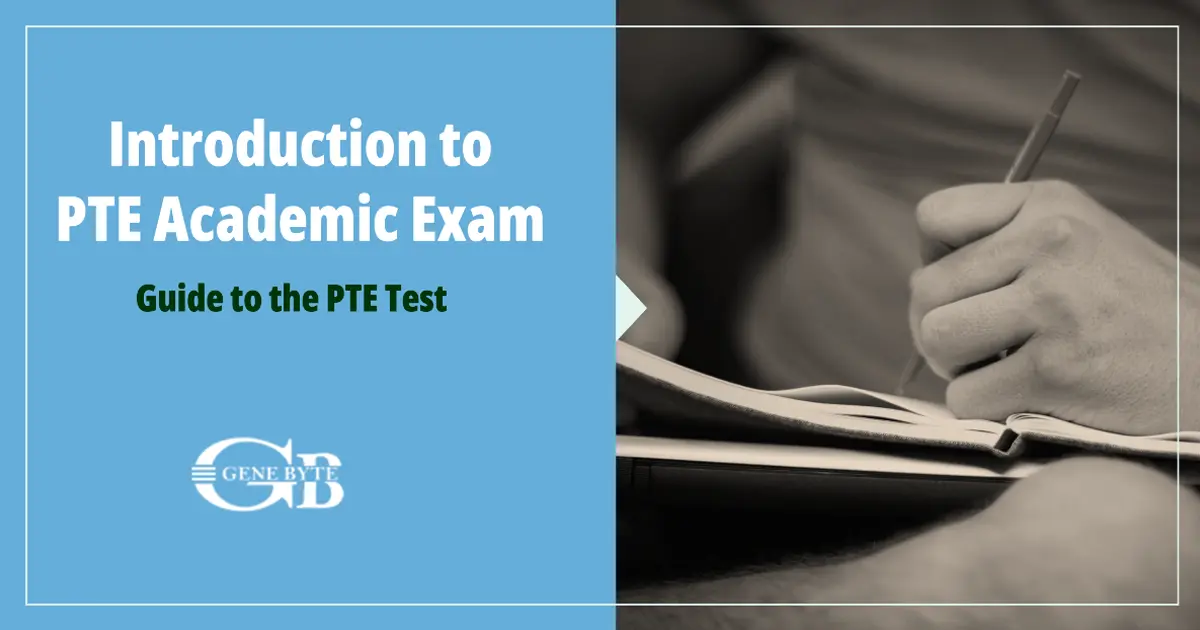Discussing the PTE Academic Exam:
An Essential Guide for Teachers
Unlocking the PTE Academic Test for Educators

"PTE Academic not only tests your English skills but integrates these skills across sections, making it a comprehensive reflection of your language proficiency in real-world scenarios."
As a teacher in the world of English language proficiency tests, have you considered the intricacies of the PTE Academic exam? At Genebyte, we help educators understand and navigate this exam, providing essential tools to boost student success.
Key Takeaways:
- Exam Structure: The PTE Academic exam has four sections: Speaking, Writing, Reading, and Listening, each with various question types.
- Understand the Exam: Learn the PTE Academic exam's structure and scoring.
- Importance for Educators: Knowing the exam's format and scoring helps teachers improve their teaching methods.
- Improve Teaching: Tailor methods to boost student success.
- Use Innovative Tools: Elevate training with Genebyte's solutions.
Transform your teaching approach with Genebyte's insights and tools for better student performance.

Introduction to PTE Academic Exam
Overview of PTE Academic as a Computer-Based English Proficiency Test
Pearson offers two main English language tests, the newer PTE Core and the established Pearson Test of English Academic, commonly known as the PTE Academic, which stands at the forefront of English proficiency assessment. Both of these tests are computer-based, and have redefined language proficiency evaluation in the digital age. They are globally recognized for their accuracy, fairness, and innovative approach, making them a preferred choice for students and Canadian PR aspirants alike.
Unique Characteristics of PTE Academic:
- Computer-Based Testing: The entire test is conducted on a computer, ensuring a standardized testing environment.
- Variety of Question Types: It includes 20 different types of questions, spread across four main sections: Speaking, Writing, Reading, and Listening.
- Analytical Scoring System: Scores are not only based on correct answers but also consider factors like fluency and relevancy, providing a holistic assessment of language proficiency.
Importance of PTE Academic in Global Education and Migration
The PTE Academic exam is not just a test of English language skills; it's a gateway to global opportunities in education and career. Its acceptance by universities, governments, and professional bodies worldwide is testament to its credibility and reliability.
Global Recognition:
- Academic Admissions: Widely accepted by universities worldwide, including prestigious institutions.
- Immigration Purposes: Recognized for visa applications in major English-speaking countries.
- Professional Certification: Used by professional bodies for certification and registration purposes.
Impact on Teaching and Learning:
- Teaching Strategies: Understanding the PTE Academic format is crucial for educators to tailor their teaching methods effectively.
- Learning Focus: Students benefit from a focused approach to learning, emphasizing real-life language skills.
Genebyte's innovative SaaS solutions are designed to assist educators in navigating the complexities of PTE Academic preparation. By leveraging our technology, educators can provide targeted and effective training, significantly improving student outcomes.

Structure of PTE Academic Exam
Detailed Breakdown of the Speaking Section
The Speaking Section of the PTE Academic exam is a critical component that assesses a candidate's oral proficiency in English. This section is designed to mimic real-life scenarios where English is used, making it a practical and relevant measure of a student's ability to communicate effectively.
Key Characteristics of the Speaking Section:
- Duration and Format: The Speaking section typically lasts for about 24 to 27 minutes.
- Question Types: It comprises various tasks such as Read Aloud, Repeat Sentence, Describe Image, Retell Lecture, and Answer Short Question.
- Skills Assessed: This section evaluates not just speaking skills but also how well candidates comprehend and respond to spoken English, impacting their scores in reading and listening skills.
Overview of the 5 Question-Types in This Section
-
Read Aloud:
- Task: Candidates read a text aloud.
- Skills Tested: Reading and speaking skills are assessed.
- Number of Items: Typically 6 to 7 items.
-
Repeat Sentence:
- Task: Candidates hear a sentence and repeat it.
- Skills Tested: Both listening and speaking skills are evaluated.
- Number of Items: Approximately 10 to 12 items.
-
Describe Image:
- Task: Candidates describe an image in detail.
- Skills Tested: Mainly focuses on speaking skills.
- Number of Items: Generally 3 to 4 items.
-
Retell Lecture:
- Task: Candidates listen to a lecture and then retell it in their own words.
- Skills Tested: Assesses both listening and speaking skills.
- Number of Items: Usually 1 to 2 items.
-
Answer Short Question:
- Task: Candidates answer a question based on a short audio.
- Skills Tested: Tests listening and speaking skills.
- Number of Items: Around 5 to 6 items.
At Genebyte, we understand the intricacies of each question type in the PTE Academic's Speaking section. Our SaaS solutions provide comprehensive analytics and feedback, helping educators tailor their teaching methods to enhance students' performance in this section. We offer practice materials and templates that mirror the structure and challenges of the actual exam, ensuring that students are well-prepared and confident.

Detailed Breakdown of the Writing Section
The Writing Section in the PTE Academic exam is a critical component that evaluates a candidate's ability to articulate ideas in written English. This section is designed to mimic real-life academic and professional writing scenarios, making it a vital measure of a student's writing proficiency.
Key Characteristics of the Writing Section:
- Duration and Format: The Writing section spans 30 to 40 minutes, testing the candidate's ability to respond quickly and effectively.
- Focus on Academic Content: The tasks are designed to reflect real-life academic situations, preparing students for challenges they might face in an academic environment.
- Scoring Method: Reflecting the real-world use of language, the scoring considers both content and form, making it essential for students to demonstrate clarity, coherence, and correctness in their writing.
Overview of the 2 Question-Types in This Section
-
Summarize Written Text:
- Task: Candidates are required to summarize a text in a single sentence.
- Skills Tested: Focuses on the ability to comprehend, analyze, and condense information.
- Key Strategy: Teaching effective summarization techniques becomes crucial, and Genebyte's tools can help educators in guiding students to identify key points and articulate them concisely.
-
Write Essay:
- Task: Candidates need to write an essay on a given topic.
- Skills Tested: Assesses the ability to develop an argument, structure ideas logically, and use language effectively.
At Genebyte, we recognize the challenges posed by the Writing section of the PTE Academic. Our SaaS solutions are tailored to address these challenges, providing comprehensive resources and real-time feedback. We empower educators with tools to refine their teaching methods, focusing on enhancing students' writing skills.

Detailed Breakdown of the Reading Section
The Reading Section of the PTE Academic exam is a vital component that evaluates a candidate's ability to comprehend and interpret written English. It presents an array of question types designed to assess various aspects of reading skills, from understanding main ideas to interpreting subtle nuances in texts.
Key Characteristics of the Reading Section:
- Duration and Complexity: The Reading section typically spans 29 to 30 minutes, comprising tasks that range in complexity.
- Integration with Other Skills: It not only assesses reading proficiency but also integrates with writing skills, underscoring the interconnected nature of language use.
Overview of the 5 Question-Types in This Section
-
Reading and Writing: Fill in the Blanks:
- Description: A text with missing words where candidates select appropriate words from a list.
- Skills Assessed: Tests reading comprehension and contextual vocabulary usage.
-
Multiple-choice, Choose Multiple Answer (Reading):
- Description: Candidates choose multiple answers after reading a text.
- Skills Assessed: Focuses on the ability to analyze and evaluate written information.
-
Re-order Paragraph:
- Description: Involves arranging jumbled sentences into a coherent paragraph.
- Skills Assessed: Tests understanding of textual flow and logical coherence.
-
Reading: Fill in the Blanks:
- Description: Similar to the first type, but focuses more narrowly on vocabulary knowledge.
- Skills Assessed: Emphasizes understanding word choice and grammatical structure.
-
Multiple-choice, Choose Single Answer (Reading):
- Description: Involves selecting one correct answer after reading a text.
- Skills Assessed: Tests specific understanding of a text and ability to identify key ideas.
At Genebyte, we recognize the challenges posed by the Reading section of the PTE Academic. Our SaaS solutions provide teachers with resources and analytics to better prepare students for this section.

Detailed Breakdown of the Listening Section
The Listening Section in the PTE Academic exam is a key component that assesses a candidate's ability to understand spoken English in an academic context. This section tests a range of skills from comprehending the gist of a lecture to identifying specific information in a conversation.
Key Characteristics of the Listening Section:
- Duration and Diversity: The Listening section varies from 30 to 43 minutes, featuring a mix of question types that challenge different aspects of listening comprehension.
- Integration with Other Skills: It contributes scores to the reading and writing sections, demonstrating the integrated nature of language skills in real-life communication.
Overview of the 8 Question-Types in This Section
-
Summarize Spoken Text:
- Task: Summarize a short lecture or talk.
- Skills Assessed: Comprehension of main ideas and key details.
-
Multiple-choice, Choose Multiple Answer (Listening):
- Task: Select multiple answers from a list after listening to a recording.
- Skills Assessed: Ability to identify specific information and understand a speaker's purpose.
-
Fill in the Blanks (Listening):
- Task: Fill in missing words in a transcript as you listen.
- Skills Assessed: Detailed listening and understanding of vocabulary in context.
-
Highlight Correct Summary:
- Task: Choose the summary that best matches the recording.
- Skills Assessed: Overall understanding and ability to distinguish key points.
-
Multiple-choice, Choose Single Answer (Listening):
- Task: Choose one correct answer after listening to a recording.
- Skills Assessed: Identifying the main idea or theme of the recording.
-
Select Missing Word:
- Task: Identify a missing word at the end of a recording.
- Skills Assessed: Prediction and understanding of the context.
-
Highlight Incorrect Words:
- Task: Identify words in a transcript that differ from what was said.
- Skills Assessed: Detailed listening and distinguishing between similar sounds.
-
Write from Dictation:
- Task: Write a sentence exactly as you hear it.
- Skills Assessed: Listening and writing accuracy.
Genebyte's SaaS platform plays a pivotal role in improving students' performance in the Listening section. By offering tailored practice sessions and real-time feedback, we enable educators to focus on areas where students need the most improvement.

Scoring Dynamics in PTE Academic
The Complex Algorithm Behind Scoring
Scoring in the PTE Academic exam is far from straightforward. It employs a complex algorithm that evaluates not just the accuracy of responses but also factors such as task difficulty and average scores. This sophisticated system ensures a fair and comprehensive assessment of a candidate's language skills.
How Scoring Relates to Different Skills
The scoring system in PTE Academic is uniquely integrated. It means that performance in one section can impact the scores in other sections. This integrated scoring system is reflective of real-world language use where skills are interconnected and not isolated.
- Listening and Writing Integration: For example, in tasks like 'Summarize Spoken Text,' the candidate's ability to listen and then write a summary is evaluated, merging listening and writing skills.
- Reading and Listening Synergy: Similarly, tasks in the Speaking section often require skills that are also used in the Reading and/or Listening section, highlighting the interplay between these two skills.
Analysis of Integrated Scoring and How It Impacts Teaching Strategies
Integrated scoring necessitates a holistic approach to language teaching. At Genebyte, we understand this interconnection and our SaaS solution is designed to help teachers develop comprehensive teaching strategies.
Genebyte's Role in Optimizing Teaching Strategies
- Holistic Teaching Approach: Our platform encourages a comprehensive teaching methodology that addresses the interconnected nature of language skills.
- AI-Driven Insights: Genebyte's advanced analytics provide insights into each student's performance across different skills, allowing for targeted improvements.
- Customizable Practice Sessions: Teachers can create practice sessions that mirror the integrated scoring system of the PTE Academic, preparing students more effectively.

Unique Features of PTE Academic Exam
Examination of the Computer-Based Format and Its Advantages
The PTE Academic exam is renowned for its computer-based format, providing a modern approach to language proficiency testing. This digital format offers several advantages:
- Consistency and Fairness: Automated scoring eliminates human bias, ensuring a level playing field for all test-takers.
- Flexibility and Accessibility: With computer-based testing, scheduling and taking the exam becomes more convenient, accommodating a wider range of candidates.
- Real-Time Results: Faster processing of results means that students and institutions can proceed with their plans without delay.
Explanation of the Varied and Dynamic Question-Types
PTE Academic's diverse range of question types is designed to comprehensively assess a student's English language skills. These question types include:
- Writing: This section tests skills like summarizing written text and essay writing, emphasizing the writing abilities.
- Reading: Tasks like re-ordering paragraphs and multiple-choice questions evaluate the candidate's ability to understand written English.
- Listening: This section involves summarizing spoken text, filling in blanks, and multiple-choice questions, focusing on the comprehension of spoken English.
Each question type in the PTE Academic is crafted to reflect real-world scenarios, preparing students for the practical use of English in academic and professional settings.

PTE Academic Exam's Impact on Teaching
The Importance of Understanding the PTE Format for Effective Teaching
Understanding the PTE Academic format is crucial for effective teaching strategies. This comprehensive knowledge enables teachers to guide students more effectively through the exam's intricacies. The PTE Academic exam's unique integrated scoring and various task styles require a deep understanding to develop effective teaching methods.
Strategies for Coaching Institutes to Prepare Students
Coaching institutes must adopt strategies that mirror the PTE Academic's diverse and integrated approach:
- Integrated Skill Development: Develop teaching strategies that focus on integrated skills assessment, similar to the PTE Academic's format.
- Mock Tests and Practice Sessions: Regular mock tests that simulate the actual PTE Academic environment help students familiarize themselves with the exam's format and time constraints.
- Focus on Real-World Language Use: Encourage practices that reflect the real-world application of language skills, preparing students for the practical aspects of the test.
Role of Teachers in Enhancing Students' Adaptability to the Exam's Format
Teachers play a pivotal role in enhancing students' adaptability to the PTE Academic's format:
- Guidance on Task Management: Educators should guide students on effectively managing different tasks within the exam, especially those with integrated scoring.
- Tailored Feedback: Providing individualized feedback based on mock test performances can help in addressing specific areas of improvement.
- Technique Training: Training students on specific techniques for various question types, especially those with subjective-style answers, is vital.

Genebyte's Role in PTE Academic Preparation
Introduction to Genebyte's SaaS Solutions for PTE Academic Preparation
Genebyte has revolutionized PTE Academic preparation with its innovative SaaS solutions. Our platform is specifically tailored to align with the unique demands of the PTE Academic exam, offering an array of tools and resources that enhance teaching and learning experiences.
How Genebyte Aids Teachers in Understanding and Teaching PTE Academic
- Comprehensive Curriculum Coverage: Our solutions encompass all aspects of the PTE Academic exam, providing teachers with a complete toolkit for effective instruction.
- Interactive Learning Environments: Genebyte's platform offers interactive modules and real-time practice scenarios that mimic the PTE Academic format, enabling teachers to deliver engaging and effective lessons.
- Customizable Teaching Aids: Educators can tailor the learning content to meet the specific needs of their students, thanks to the customizable features of our platform.
Benefits of Using Genebyte's Solutions for Coaching Institutes
Genebyte's SaaS solutions offer numerous benefits to coaching institutes preparing students for the PTE Academic exam:
- Enhanced Teaching Efficiency: Our platform streamlines the preparation process, allowing teachers to focus on delivering high-quality instruction rather than administrative tasks.
- Data-Driven Insights: AI-powered analytics provide detailed insights into student performance, enabling targeted teaching strategies and personalized learning experiences.
- Increased Student Engagement: With a range of interactive tools and resources, students remain engaged and motivated throughout their preparation journey.
- Success Stories: Real-life examples from our partner institutes illustrate how Genebyte's solutions have led to significant improvements in student outcomes and overall institute performance.

Challenges in PTE Academic Preparation and Genebyte's Solutions
Common Challenges Faced by Students and Teachers in PTE Academic Prep
Preparing for the PTE Academic exam presents a unique set of challenges for both students and educators. These challenges often include:
- Navigating the Integrated Scoring System: Understanding how skills are interrelated and scored can be complex.
- Dealing with Varied Question Types: The diversity of question formats requires adaptable strategies and a deep understanding of the exam's structure.
- Time Management: Efficiently managing the limited time given for each section is often a significant hurdle for students.
How Genebyte Addresses These Challenges with Technology and Expertise
Genebyte's SaaS solutions are specifically designed to tackle these challenges head-on, leveraging technology and educational expertise:
- Interactive Learning Tools for Integrated Scoring: Our platform offers tools that help students understand and practice the integrated nature of the PTE Academic scoring system.
- Adaptive Practice Sessions: With a variety of question types and mock exams, students can adapt to the diverse formats of the PTE Academic.
- Time Management Training: Genebyte's tools include timed practice sessions, helping students develop the crucial skill of time management.
Genebyte's Impact on PTE Academic Preparation
- Personalized Learning Paths: Utilizing AI, Genebyte's platform identifies individual student weaknesses, allowing for targeted practice.
- Real-Time Feedback: Immediate feedback on practice tests helps students quickly rectify mistakes and understand the nuances of the PTE Academic exam.
- Expert Resources: Access to comprehensive study materials and expert advice ensures that both teachers and students are well-equipped for the exam.

Actionable Tips for PTE Academic Preparation
- Integrate Skills: Teach language skills together, blending reading, writing, speaking, and listening.
- Use Technology: Incorporate tools that simulate the PTE Academic's computer-based format.
- Practice Variety: Expose students to different question types and formats regularly.
- Focus on Time Management: Teach effective time management strategies for the exam.
Genebyte's Role in PTE Academic Preparation
Our tools help students excel in exams and gain real-world language proficiency. We provide a comprehensive digital platform designed to enhance PTE Academic preparation. Our B2B SaaS solution offers:
- Advanced Analytics: Personalized student learning paths.
- Real-Time Feedback: Resources aligned with the latest PTE standards.
Transform Your Teaching Approach
Ready to improve your PTE Academic preparation? Discover Genebyte's innovative solutions. Visit our website, schedule a demo, or contact us for more information.
Frequently Asked Questions
Yes, the PTE Academic exam includes multiple-choice questions as part of its diverse question types. However, it's not limited to them. The test also incorporates other formats like essay writing, summarizing spoken text, and fill-in-the-blanks, making it a comprehensive assessment of English language proficiency.
In certain question types of PTE Academic, there is negative scoring, particularly in multiple-choice questions. It's designed to discourage guessing. It's important for test-takers to be aware of this to strategize their answering approach effectively.
The scoring potential varies across sections. However, the Speaking section often has significant weight as it also contributes scores to the Reading and Listening sections. This integrated scoring system underscores the importance of proficiency in all language skills.
Yes, certain question types, especially in the Speaking and Listening sections, tend to have repetitive patterns. Familiarity with previous exam questions can be advantageous as it helps in understanding the exam format and potential content.
Pearson occasionally trials changes in the PTE's format, which can affect the timing of the exam. These trials may lead to variations in the allocated time for each section, making it crucial for candidates to stay updated and practice time management.
PTE's scoring algorithm is complex and takes into account the difficulty level of each task. It's not a straightforward cumulative scoring system. The algorithm assesses responses based on various factors, including accuracy and relevance, adjusting the score accordingly.
While memorizing past questions and answers can provide insight into the exam's structure, it should not be the sole focus. Understanding the underlying skills and being able to apply them in varied contexts is more crucial for success.
Yes, templates can be effectively used for subjective-style answers in PTE, especially in the Writing and Speaking sections. They help structure responses and ensure that all critical points are covered within the time constraints.
Effective strategies vary with question types. For instance, skimming and scanning techniques are beneficial for reading tasks, while structured approaches and templates work well for writing and speaking tasks. Practice and familiarity with each question type are key.
Teachers can adapt by staying updated with the latest exam patterns, incorporating technology in teaching, and focusing on integrated skill development. Utilizing resources like Genebyte's SaaS solutions can also be highly effective in aligning teaching methods with the exam's requirements.
In PTE Academic, integrated scoring means that responses in one section can contribute to scores in other sections. For example, the Speaking section not only evaluates speaking skills but also contributes to reading and listening scores. This approach reflects the interconnected nature of language use.
The PTE speaking section can be challenging due to factors like the need for clear pronunciation, coherent structure, and time management. However, with systematic practice and familiarity with the question types, candidates can significantly improve their performance in this section.